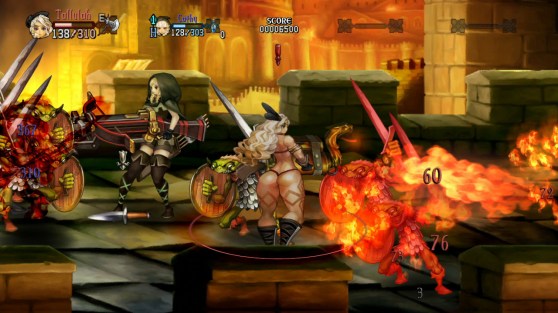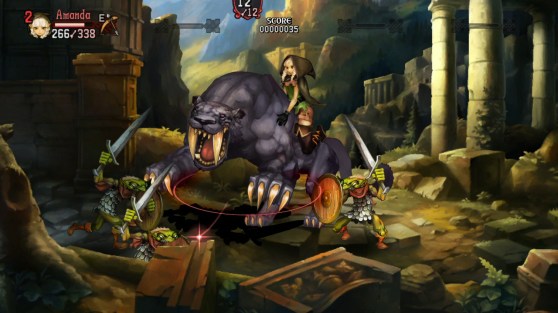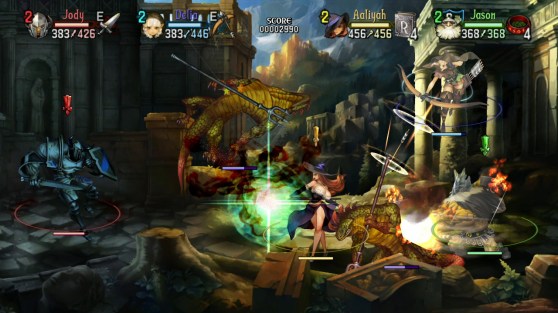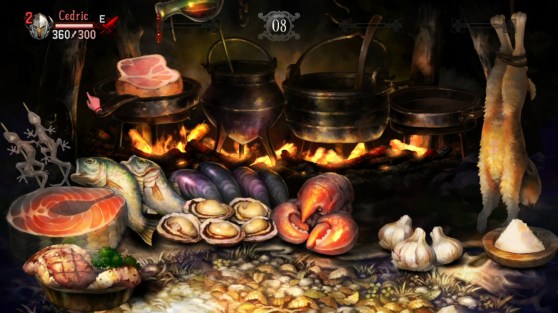One tragic Google search can completely ruin Dragon’s Crown for you. Women characters have exaggerated, inhuman proportions, and some wear virtually no clothing at all. Indeed, if you focus all your attention on the fact that the Amazon is going on an epic quest in a thong, then it’s totally understandable that you may dismiss the rest of Dragon’s Crown as exploitative trash.
The lead artist and designer for Dragon’s Crown, developer Vanillaware’s George Kamitani, draws in an identifiable and fantastic style. The trouble with Dragon’s Crown is the emphasis placed on breast animations and grotesque proportions and how they can distract from — and even eclipse — the game you’re playing. Kamitani defends his work by citing Western genre fantasy tropes and designs that influence countless other fantasy games, movies, and books. The most difficult part of accepting Kamitani’s work is balancing his motivation with the modern push to move away from depicting women as scantily clad objects. However, it is possible to look past the art and enjoy the game it illustrates.
Dragon’s Crown is a PlayStation 3 and Vita side-scrolling brawler (a bit like Sega’s Golden Axe) with a fleshed-out story and inventory system. It turns the Golden Axe model into a semi-roguelike, meaning you’ll go through dungeons with limited equipment and the real danger that every battle could kill you. It’s a satisfying blend of nonstop baddie smashing and easily completed objectives that vary depending on the quests you’ve agreed to. Pushing past the initially off-putting art style opens up a game full of clever pop culture references and addictive dungeon-crawling.
What you’ll like
Searching for loot
Beating up monsters is satisfying in its own way, but getting lots of money and items while doing so is even better. Everywhere you go in Dragon’s Crown is overflowing with treasure. You’ll encounter various secret doors, locked chests, and even suspicious sparkling walls that you can guide a little pointer over to reveal hidden trinkets.
When you start poking around after a fight, it’s easy to miss treasure that might have dropped from one of the many enemies you killed (or other goodies that may be lying around). Dragon’s Crown gives you a hand with treasure management with Rannie, an opportunistic rogue who rushes out to pick locks and gathers stray loot. Letting him tackle locked areas also frees you up to focus on any approaching enemies.
Calling Rannie out to help is fairly simple. As you fight, you can use the right analog stick (or the touch screen on the Vita) to control a cursor. Clicking on interactive objects sets Rannie about his task, and all you have to do is keep him from taking too much damage. Later on in Dragon’s Crown, you can also use the cursor to activate magical runes that give you stat bonuses or unlock even more treasure.
Resurrecting heroes
When you take on the quest to find the Dragon’s Crown and subdue an ancient, world-destroying dragon, you’re not alone. Countless heroes from all over the world have tried to fight against hordes of orcs and demons, but few survive. As you explore, you’ll stumble across grumpy piles of bones remembering their dying words. You can collect these corpses and take them back to the temple in the main hub village, where you may either revive them or bury them.
Each corpse is actually a fallen fighter resembling one of the six character classes in Dragon’s Crown. You can recruit them into your party during the offline portions of the game or let them randomly appear as you explore. Computer-controlled allies will pop in to help you fight just like online players do.
After you unlock the ability to join up with other players, you’ll find high-level bones scattered through the dungeons that can provide invaluable support when you’re walking into a difficult boss fight. It turns out that when you die in dungeons, your bones drop somewhere in the level, so the more powerful characters are just computer representations of real players who have died.
You can customize what your character says when they’re revived or join battles, but the most entertaining dialog snippets are already in Dragon’s Crown. I’ve spent the last week trying to get the They Might Be Giants song “The Statue Got Me High” out of my head after one of the corpses quoted the song’s final words.
Clever references
They Might Be Giants references are just the beginning for the various pop-culture trinkets scattered throughout Dragon’s Crown. As you explore, you’ll find references to Conan the Barbarian, Golden Axe, Castlevania, old Mickey Mouse cartoons, The Elder Scrolls V: Skyrim, and even Monty Python and the Holy Grail. Usually, these kind of kitschy throwbacks annoy me, but that’s because games often go out of their way to explain the jokes.
In Dragon’s Crown, you might catch the reference, or you might not, but the adventure isn’t tied to you noticing them. When you do get the joke, though, Dragon’s Crown feels much more alive.
PlayStation 3 vs. Vita
Many games available on both the PS3 and the Vita don’t hold up across platforms. This is not the case for Dragon’s Crown. Both versions look and function beautifully, and you won’t find the shift in screen size too troubling. You can play online either way, and you can even upload your saves to a server that lets you play for a while on one platform before moving to the other.
I really enjoy the Vita version more because it’s portable and you can also tap the screen to gather goodies and unlock chests. I find that tactile element is really helpful when you need to gather money quickly or open a chest before rushing out of an area. Moving the analog stick on the PS3 controller works almost as well, but I find poking around for gold a little more satisfying when I do it manually.
The one downside to Dragon’s Crown, though, is that you will not get cross-buy support. It does support cross-play (meaning you can share saves), but you will have to buy a PS3 and a Vita version to do this. Atlus did give me access to both versions of Dragon’s Crown for this review, but you might want to choose which platform you’re more likely to play it on.
But as far as I can tell, you will be happy no matter which version you choose.
What you won’t like
Occasional online frustration
Once you play through the first nine story missions, you’ll unlock the multiplayer mode. You can team up with friends or open up your party to random people. Sometimes, independent partners can totally screw up a mission.
The latter half of Dragon’s Crown is all about defeating powerful bosses in a limited amount of time so you can gather talismans you need to fight off a dragon. Some of these fights give you the option to run away from a boss when you’re weak so you can collect more healing items, but doing this will completely ruin your completion time. It’s not wise to play with random online partners when you’re trying to defeat a boss in time to get the talisman you need to further the story. Other players can drag you through doors and away from fights easily, and particularly obnoxious ones will rush through levels before you have time to open chests or complete quest objectives.
I’m sure that if you’re playing online with people you trust, this is less problematic, but I frequently met players who just wanted to hurry me along rather than letting me complete an objective. You don’t really have a way to communicate what you’re doing other than standing still and refusing to budge, but sometimes that just isn’t enough.
The art
It’s totally understandable if you find the art in Dragon’s Crown offensive, repulsive, and demeaning to women. It really is, but we should also take a second to consider what games and media influenced the game. Golden Axe depicts various underclothed warrior types in fur boots and loin cloths. All the characters in the original Sega arcade game and later Genesis versions are notably without protective clothing, but they are not depicted in an overly sexual light. That wild barbarian vibe does make its way into Dragon’s Crown.
That influence is likely coming from Western genre fantasy. Snake women with breasts, overly sexualized Amazonian fighters laying waste to monsters in bikinis, and women contorting themselves in impossible ways all comes out of fantasy artist Boris Vallejo’s work. He’s not alone in depicting fantasy worlds as oily, sweaty, naked places, and it’s easy to see how those images would work their way into a semi-Western inspired “let’s go slay the dragon” adventure.
Dragon’s Crown plays like a Dungeons & Dragons inspired brawler, borrowing a great deal from fantasy stories where random (and sometimes unusual) characters team up for a common goal. Putting a tradition-driven Amazon or a sultry sorcerer next to the modestly dressed female elf archer accentuates the idea that heroes from all walks of life are coming together to save the day, regardless of their appearance and history. Every character you encounter in Dragon’s Crown is drawn in the same exaggerated style, not just the female ones. This stylistic choice doesn’t single out women for revealing/repulsive interpretations but supports the idea that the entire world is pure fantasy.
I also argue that we treat various fetishistic illustrations differently, and often without thinking. To me, I do not see much difference in Kamitani drawing to appeal to his aesthetic sense and American cartoonist Robert Crumb openly creating work that appealed to his tastes. Crumb’s work often depicts women with massive, impossibly large legs, much like the Amazon in Dragon’s Crown. Kamitani is free to design his characters according to his standards, even if they make us uncomfortable. That uncomfortable feeling might be his aim or his challenge to audiences who shy away from bare forms in various shapes and sizes.
I’m sure people find a lot to dislike in Crumb’s often disgusting work, and people are still free to remove themselves from it. But I think Crumb’s creativity outshines the sometimes abrasive way he draws, and the same is true for Kamitani. His art is beautiful, albeit sexually charged. It does not detract from the solid gameplay it illustrates and actually reaffirms the idea that the game world is nothing like our own. But you’re free to skip Dragon’s Crown because of it’s style.
It’s up to the player to decide if DC’s art is acceptable or not, but understanding possible inspirations and motivations can help you make a more reasoned decision beyond disliking Kamitani’s work solely because female characters are skimpily clothed.
Brutal economy
You might not realize it, but many video games strive to balance the amount of money you find with the cost of items in stores. This balance is easily disrupted by the price of services and items exceeding the rate at which you obtain money. The deeper you get into Dragon’s Crown, the more you’ll realize how delicate that balance is.
When you run out of lives in a dungeon, or your A.I. partners do, you can pay for their resurrections. Understandably, the price goes up every time you take advantage of the service, but the cost will soon outstrip the amount of gold you find. This is a clear punishment for overusing the in-mission revival feature, but it can also cost you valuable progress and A.I. companions if you come up short in the middle of a fight.
Losing yourself in the action
This complaint might be my own visual impairment, but when the battle gets rough in Dragon’s Crown, I completely lose track of where my character is on the screen. Vanillaware did include little colored arrows that correspond to your position in the party, but sometimes those indicators simply aren’t enough.
When magic starts flying, Amazons start flipping and spinning across the battlefield, and someone keeps summoning monsters to help fight, the screen quickly gets too cluttered to tell where the monsters start and the party ends. I would often find myself up in the top corner, uselessly thrashing at nothing when I thought I was deep in the colorful mess at the center of the screen. I only realized I wasn’t when the action shifted further away from me.
When I started playing Dragon’s Crown, I was using my Vita, and assumed my inability to keep track of my place was because of the screen size. Once I booted up my save on PS3, I realized that it wasn’t the screen size. No matter which platform you’re on, it is easy to zone out and hope you’re still attacking when you’re likely nowhere near the battle.
Everything in Dragon’s Crown is colorful and wonderfully animated, but I think that might be to its detriment. Maybe some actions don’t need thorough animations, like the sorceress’ breasts flailing wildly when she runs, or the elf archer constantly summersaulting as she avoids attacks. The screen is just too damn busy at times, making it difficult for you to stay focused.
Conclusion
Say what you want about the stylistic choices that went into art, but Dragon’s Crown’s appeal is greater than its looks. Smashing baddies, exploring dungeons, and scrounging for as much money and items as you can find is a satisfying departure from many strategy-heavy games coming out these days. Dragon’s Crown is a nostalgic return to classic side-scrolling brawlers found in arcades in the early ’90s, complete with flashing “go” arrows and food that falls out of villains and chests.
I know the art is a problem for many, and I would be lying if I said it didn’t bother me. Understanding the influences, both artistic and thematic, helps me appreciate Dragon’s Crown even though I don’t want to see undulating breasts every five seconds. I can look beyond them and lose myself in the mechanics and combat. Hopefully, you’ll give it a chance.
Score: 90/100
Dragon’s Crown is a side-scrolling brawler coming out on PlayStation 3 and Vita on Aug. 6, 2013. Publisher Atlus provided digital copies of the Vita and PS3 versions of the game for this review.
VentureBeat's mission is to be a digital town square for technical decision-makers to gain knowledge about transformative enterprise technology and transact. Learn More





